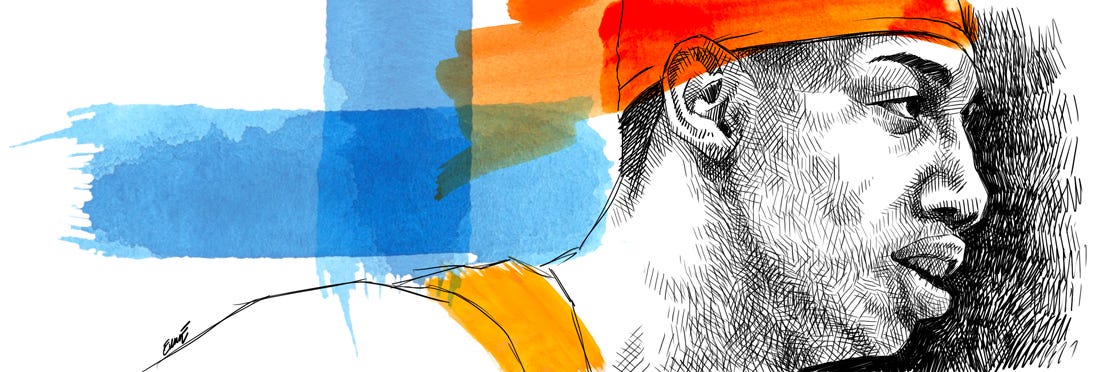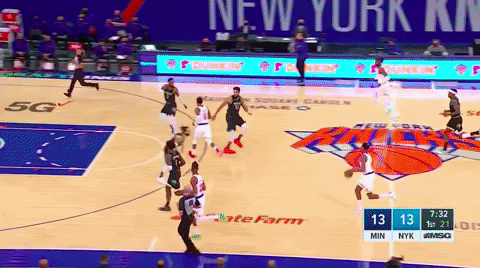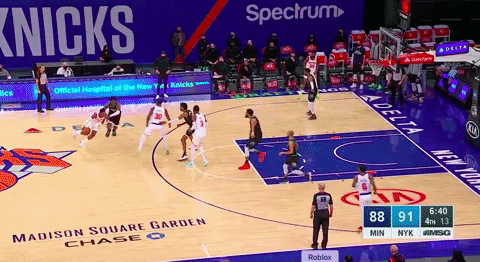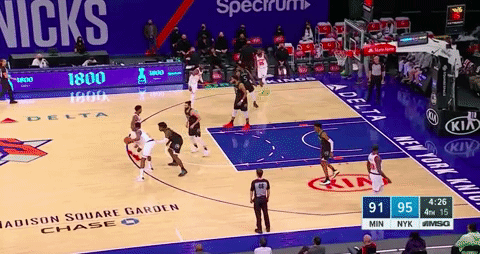First Half Report Card: RJ Barrett
He should still be in college, so it seems only appropriate that we start our first half report cards with the 20-year-old Dukie.
Today’s edition is free for all, but if you’d like to become a full subscriber, you can do so here:
🏀 Who: Golden State Warriors (16-15, plus 1.4 net rating - 10th in the NBA, 20th in offense, 5th in defense)
⌚️ When: 7:30 pm
½ Halftime Zoom: Click here to enter.
📍 Where: The World’s Most Famous Arena
🤕 Who’s Out: Mitchell Robinson for the Knicks.
Steph Curry, who missed Sunday this weekend’s game in Charlotte with an illness, was a full participant in Monday’s practice and is expected to play. Fan-fucking-tastic.
Meanwhile, Warriors coach Steve Kerr is optimistic that both James Wiseman (wrist) and Kevon Looney (ankle) will be able to go. If both are available, Kerr said Looney will likely start and second-overall pick Wiseman will come off the bench. That means the Knicks should expect to see a starting five of Steph, Looney, Draymond Green, Andrew Wiggins and Kelly Oubre Jr, with Eric Paschall, Kent Bazemore, Brad Wanamaker, Damian Lee and Wiseman off the bench. Not a bad group.
🔅 World’s Greatest Stage: The former two-time league MVP has a reputation for explosive scoring games at the World’s Most Famous Arena, but the numbers haven’t really bore that out.
The last game Curry played at the Garden was nearly two and a half years ago, in October of 2018, when he scored 29 in a Golden State blowout. Before that, he had scoring outputs of 21, 31, 13, 22 and 27 for an average of 23.8 points per game over those six. Golden State won every game comfortably.
Ironically, the last game that the Warriors lost at MSG was Curry’s famous 54-point-masterpiece during the 2012-13 season. Here’s to him getting another 54 in another loss.
First Half Report Card: RJ Barrett
I know. I just did an RJ-centric newsletter on Friday. I need a new hobby.
But what can I say…he’s by far the most interesting Knick to analyze this season. Julius Randle is playing out of his mind, and there’s not much deeper to get than that. Ditto for Immanuel Quickley, who is still developing the sample size that we’ll later use as an analytical jumping off point. That goes doubly so for Obi Toppin. Mitch is hurt. You don’t really care about anyone else, and I don’t blame you.
RJ is different, and not just because his season has been somewhat of a roller coaster. There are nights where you see enough to make you feel foolish for ever doubting him. Hell, there’s a significant portion of the fan base that has never doubted him, choosing to look at the age, the counting stats, the demeanor, the pedigree and the pick he was taken at, and consider anyone who questions his status as a franchise cornerstone to be peddling in absurdities.
And maybe those people are correct. After all, he’s a 20-year-old currently putting up 16, 6 & 3 a night - something that only eight other men have ever done at the same age or younger. It’s not a terrible group:
Even if you look at Barrett’s less-than-ideal efficiency numbers, he’s still on par with the likes of Antoine Walker and Lamar Odom, one of whom was the second best player on a conference finalist, while the other was the third best player on a title team.
If you really want to pick nits, you can point out how the league-average effective field goal percentage has gone up from .478 to .536 since those guys were putting up their age-20 seasons, but even if he’s a poor man’s version of either one, in theory, that’s still good enough to be considered a cornerstone piece to a franchise that hasn’t exactly earned the right to be picky.
But theory isn’t reality, and the reality of the NBA in 2021 and beyond is that it is a place where inefficiency goes to die (or at the very least, comes off the bench). Every team is smart, and they’re all trying to achieve the same end goal: a crunch time five with a) two ball-dominant guys, b) two deadly shooters, and c) a roll man (and really, if you want to win a chip, your roll man can’t be just a roll man anymore, but needs to be someone from either category A or B).
The teams with the most efficient ball-dominant guys and/or the deadliest shooters win. It’s that simple. Sure, there’s margin for error. For example, Luka Doncic is such a goddamn visionary with the ball and draws so much attention that he can get away with a .531 effective field goal percentage, whereas someone like Devin Booker has to be that much more accurate to make up the difference. Or maybe you can inject a little extra playmaking into your shooters, like Utah is trying to do, to make up for the fact that your engine sputters to a few too many 9-for-24 nights (and still somehow ends up with 30).
Point is, this isn’t the 90’s, when guys could get away with efficiency numbers that might as well be from the Mikan era. Every player who handles the rock a good amount needs to be damn good at something, whether it be opening up looks for teammates, finishing at an elite rate, creating off the dribble on the perimeter, or doubling as an off-ball threat.
The reason RJ Barrett is so tantalizing is that with the exception of off the dribble creation behind the arc, he’s shown signs of being all of these. For starters, he is now up to nearly 37 percent behind the arc since his first five games. It has come on low volume - just 3.0 attempts per game - and the looks are almost never contested, but still, it’s something.
For most people, Barrett’s ceiling will be determined here. No one thinks he will ever be Klay Thompson from deep, but if he can just be Harrison Barnes - another high pedigree guy who combined just enough shooting with just enough on-ball ability to be the fourth best player on a title team - then he’s in business.
But for the most hopeful among us - yes, I still am quite hopeful about RJ’s eventual ceiling, despite what I’ve written in the past - there is another level to unlock, one that will ultimately be determined by the one thing that has never been questioned about him: his decision making.
To explain what I mean, let’s start with a look at Barrett’s second assist of this season:
There’s so much to like about this play.
Its starts off with an ultra-quick decision to grab and go - zero hesitation. Then, he keeps the live dribble long enough to get a full foot and a half in the paint, selling the possibility of an attempt at the rim enough for Oladipo to take an extra step towards the restricted area.
The only part that’s a little off is the pass itself - Reggie needs to sidestep to the left to catch it, although it doesn’t impact his ability to get the shot off.
Here’s another RJ dime from later in the same game:
This is even more impressive.
As I noted on Friday, the Barrett-to-Robinson connection has become fairly proficient for the Knicks, with RJ responsible for more assists to the Knicks big man than any other player this season. Here, he uses that threat to draw the corner defender into the paint to tag the rolling Mitch, and then kick it out to Bullock for another triple.
Again, the pass itself is a little off, and again, it didn’t matter.
Let’s take a look at one more, my favorite:
I mean, what a find.
Barrett not only has to see over the defense, but get the pass over two separate defenders to Burks in the corner. He’s off a tad (are you sensing a trend?) but it does the trick.
This is the sort of play that few big wings in the league are able to make, let alone ones not yet old enough to drink. Passes like this were not only encouraging for Barrett, but for the Knicks as well, who were 11th in the league in assist percentage over the season’s first five games.
Since then, they’re second to last. Obviously this isn’t all on Barrett, but it is interesting to note that over the first four games of the season, RJ had nine dimes off of made threes, and in addition to the three clips above, a few more were of the drive and kick variety.
Since that first week though, Barrett has had just 23 dimes resulting in threes in 27 games. I went back and watched all of them, and none are what I would define as driving and kicking. There was a transition kick to Austin Rivers, a cross court kick to Randle, a probing kick to Payton…but nothing resembling what we saw early on.
The good news is that we know he can do it. The thing to figure out now is why it’s not happening.
This is a play from early in the Wolves game.
It came in transition, with Bullock once again sitting in the corner. The difference is that there was no roll man for Anthony Edwards to tag, and he was thus in the way of any possible Barrett kick to the corner.
That roll man - Noel - does make an appearance, and is wide open under the hoop when Barrett goes up for the shot. Given the passes we’ve seen him make over the last 16 months, it’s safe to say that he could have adjusted in midair to dump it off to Nerlens for an open look. He didn’t.
There’s two ways to look at this: Barrett was afraid that stone hands would bumble the pass, or he just thought this this was an efficient enough attempt to take so early in the clock. Was it? Barrett is hitting 35 percent of short mid-rangers this season, which is much better than last year but still below the median for his position.
This year is all about development, but development doesn’t just mean practicing tough shots at game speed; it also means making the right call when the opportunity presents itself, which is exactly what Barrett does here.
This time, his alternative option - one that RJ could have made easily by not snaking back into the middle - is to kick it to the corner. But waiting there was Elfrid Payton, who is hitting just 27 percent of his corner threes this season. Payton’s presence as the kick out option has definitely been a culprit in RJ’s lack of kicks to the corners, but not as much as you might think.
Barrett’s look doesn’t go down, but it was a good one, and one you don’t mind him taking when it presents itself. Even if his 55 percent on shots at the rim still leaves much to be desired, the math says it was the right move.
Much later in the game, RJ again has Payton as his only corner outlet, and this time his decision is less defensible.
This is similar to the play from above where Barrett avoids the dump off to Noel, except in a much more high stakes situation.
The most frustrating thing about the play is that the former third overall pick does exactly what he’s supposed to do: draw a crowd. By the time he puts the shot up, there are four Timberwolves with their attention on him.
That meant an open Bullock on the wing, and an even more open Randle behind the play. Passing to either would have been the better decision.
And that wasn’t even the most egregious blind eye Barrett turned at the end of this game:
We all had fun on Twitter last year with the clips of RJ wide open in the corner, jumping up and down waiting for either Julius Randle or Elfrid Payton to give him the time of day. Here, Randle returns the favor.
If the Knicks lost this game, this play would have stood out as much as any other as the reason why. Yes, Barrett is wide open from a distance he should convert from, and if this were one miss out of context with his overall performance this year, it wouldn’t be nearly as concerning.
But that’s not the case. Barrett is forcing more shots, and he’s doing so to the detriment of his team. Whether we look back on this as part of his “development” is entirely up to him.
Maybe a little more tough love in the fourth quarter is necessary to get to that desired finish line, but I’m betting this is a realization Barrett needs to come to on his own. Right now, he strikes me as a guy doing everything possible to prove to those watching - and to himself - that he’s every bit an alpha dog in this league. Alphas take shots like the ones we see him missing on the regular. Alphas also make enough of them to keep getting another chance.
And maybe that’s how this story ends. It’s not like we aren’t seeing significant growth:


I genuinely hope that Barrett’s finishing continues to improve, but not for the results themselves. I hope he gets there so he can once again play free and easy, like we saw in the very first game of the season, when he was willingly driving and kicking while (perhaps not coincidentally) starting nine-of-nine from the field.
To that end, of all the data I’ll be looking at over the rest of Barrett’s season, this is the most important:
This chart, courtesy of Cleaning the Glass, measures how much of Barrett’s usage is a result of assists. As you can see, it’s been a fairly steady downward trend. It’s also silly to take this as any indication of his future as a distributor. Sometimes “he’s only 20” is a disingenuous excuse for a player who just doesn’t have it; here, it’s a legitimate cause for optimism.
For Barrett to reach his ceiling, he’ll need to not only improve his ability to make buckets, both at close range and from the outside, but pick his spots more efficiently as well. If he can do that, maybe the ceiling that I’ve been leery to comfortably project is out there after all.
The ball is in his court. Now he just needs to pass it a bit more.
Grade: B+
Did you enjoy this newsletter? Want to become a full subscriber to get it daily? Go right ahead!
That’s it for today! Thanks to Ernie Parada for the RJ art, and don’t forget to check out his stuff. If you enjoy this newsletter and like the Mets, also don’t forget to subscribe for free to JB’s Metropolitan. See everyone tomorrow! #BlackLivesMatter















He needs an outside shot to set up his drives and to hit the open 3 that's all we ask
Barrett could take the next step this off-season. Basically everything will get easier for him when opposing defenses respect his 3pt shot. Basically the Larry Bird approach of taking 20,000 3pt shots a day in practice to increase his percentage, confidence and quick release. Everything other aspect of his game is as good if not better than expected.